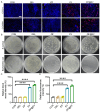Bioengineered Extracellular Vesicle Hydrogel Modulating Inflammatory Microenvironment for Wound Management
- PMID: 39684803
- PMCID: PMC11642447
- DOI: 10.3390/ijms252313093
Bioengineered Extracellular Vesicle Hydrogel Modulating Inflammatory Microenvironment for Wound Management
Abstract
Chronic wounds, frequently arising from conditions like diabetes, trauma, or chronic inflammation, represent a significant medical challenge due to persistent inflammation, heightened infection risk, and limited treatment solutions. This study presents a novel bioengineered approach to promote tissue repair and improve the healing environment. We developed a bioactive hydrogel patch, encapsulated zeolitic imidazolate framework-8 (ZIF-8) into extracellular vesicles (EVs) derived from anti-inflammatory M2 macrophages, and synthesized ZIF@EV, then embedded it in the sodium alginate matrix. This hydrogel structure enables the controlled release of therapeutic agents directly into the wound site, where it stimulates endothelial cell proliferation and promotes new blood vessel formation. These processes are key components of effective tissue regeneration. Crucially, the EV-infused patch influences the immune response by polarizing macrophages towards an M2 phenotype, shifting the wound environment from inflammation toward regenerative healing. When applied in a murine model of chronic wounds, the EV hydrogel patch demonstrated notable improvements in healing speed, quality, and tissue integration compared to traditional approaches such as growth factor therapies and foam dressings. These promising findings suggest that this bioactive hydrogel patch could serve as a versatile, practical solution for chronic wound management, providing an adaptable platform that addresses both the biological and logistical needs of wound care in clinical settings.
Keywords: bioactive hydrogel; extracellular vesicles; tissue healing.
Conflict of interest statement
The authors declare no conflicts of interest.
Figures





Similar articles
-
Injectable Nanocomposite Hydrogel for Accelerating Diabetic Wound Healing Through Inflammatory Microenvironment Regulation.Int J Nanomedicine. 2025 Feb 6;20:1679-1696. doi: 10.2147/IJN.S505918. eCollection 2025. Int J Nanomedicine. 2025. PMID: 39931526 Free PMC article.
-
Immunomodulatory hydrogel orchestrates pro-regenerative response of macrophages and angiogenesis for chronic wound healing.Biomaterials. 2025 Mar;314:122848. doi: 10.1016/j.biomaterials.2024.122848. Epub 2024 Sep 24. Biomaterials. 2025. PMID: 39342917
-
Disulfiram-loaded nanovesicles hydrogel promotes healing of diabetic wound.J Transl Med. 2024 Nov 26;22(1):1066. doi: 10.1186/s12967-024-05875-4. J Transl Med. 2024. PMID: 39593097 Free PMC article.
-
Hydrogel Loaded with Extracellular Vesicles: An Emerging Strategy for Wound Healing.Pharmaceuticals (Basel). 2024 Jul 10;17(7):923. doi: 10.3390/ph17070923. Pharmaceuticals (Basel). 2024. PMID: 39065772 Free PMC article. Review.
-
Multifunctional hydrogel-based engineered extracellular vesicles delivery for complicated wound healing.Theranostics. 2024 Jul 8;14(11):4198-4217. doi: 10.7150/thno.97317. eCollection 2024. Theranostics. 2024. PMID: 39113809 Free PMC article. Review.
References
-
- Uluer E.T., Vatansever H.S., Kurt F.Ő. Wound Healing: Stem Cells Repair and Restorations, Basic and Clinical Aspects. Wiley-Blackwell; Oxford, UK: 2018. Wound Healing and Microenvironment; pp. 67–77.
-
- Hannoodee S., Nasuruddin D.N. Acute Inflammatory Response. StatPearls Publishing LLC.; Treasure Island, FL, USA: 2023. - PubMed
MeSH terms
Substances
LinkOut - more resources
Full Text Sources

